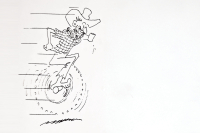Beige – the new orange
 Neotropical migrants can be flashy things — think scarlet tanager, Baltimore oriole, rose-breasted grosbeak or those tiny butterflies of the bird world like American redstart, blackburnian warbler, hooded warbler and northern parula, just to name a few. And often when we strike out in search of these colorful creatures we go to places like the Blue Ridge Parkway, where it is open and there is good light so we can see the amazing color. But sometimes beige is cool.
Neotropical migrants can be flashy things — think scarlet tanager, Baltimore oriole, rose-breasted grosbeak or those tiny butterflies of the bird world like American redstart, blackburnian warbler, hooded warbler and northern parula, just to name a few. And often when we strike out in search of these colorful creatures we go to places like the Blue Ridge Parkway, where it is open and there is good light so we can see the amazing color. But sometimes beige is cool.
I’ve been spending most of my mornings, lately, in the woods surveying bird points for the Forest Service. A lot of these points are interior forest points, home to a number of species that spend much of their life on or near the ground. Many of these species enjoy a cryptic coloration that allows them to blend into their dim forest habitats. Four warblers come to mind, ovenbird, Swainson’s warbler, Louisiana waterthrush and worm-eating warbler. These four birds are quite often noted on birders’ checklists as “heard only” because most of the time birders are too impatient to take the time to search for the diminutive camouflaged critters.
The ovenbird is probably the most common of the four. Its loud, ringing “teach, teach, teach” or “teacher, teacher, teacher” song can be heard through the woods at great distances. This thrush-like warbler is named for its nest; built on the ground, the nest resembles a dutch oven. The ovenbird is olive-brown above with heavy, dark streaking on its breast. It has a striking orange crown bordered in black and the ovenbird walks rather than hop as it forages.
The Louisiana waterthrush is another small bird with a big voice. Its song may have evolved out of necessity as it nests alongside fast moving creeks and/or rivers. Three loud, introductory whistles followed by a short jumble of notes heard above the rush of the water will alert you to the presence of this creek dweller. The Louisiana waterthrush is brown above and streaked below (not as heavily as the ovenbird) with a white eye stripe. This bird also walks rather than hops, but just to jazz it up a little it teeters, like a spotted sandpiper, as it ambles along.
While all four of these birds are often overlooked (except for their songs) the Swainson’s may be the hardest one to get a look at. This skulker likes dense cover. It often nests in canebrakes across the Southeast and in dense rhododendron thickets in the Southern Appalachians. Fortunately, it too has a big voice. Its song resembles that of the Louisiana waterthrush but it is shorter, with only two introductory notes followed by two lower notes, ending on a single high note rather than the mixed jumble of the Louisiana. The Swainson’s is olive-brown on top with an unstreaked, dingy breast and a white eye stripe.
The last of the four, the worm-eating warbler, is probably the more aerial of the four. While it nests on the ground, it forages in the understory, where it feeds primarily on caterpillars (worms.) And should you see a drab warbler on the ground hopping rather than walking — that’s the worm-eating. It is also olive above, maybe a bit greener than the other three and the unstreaked breast and cheeks often have a buffy glow. The head is black and white striped with a white crown. It has a couple of songs. One is a rapid, insect-like buzz — quite distinctive. The other is a staccato trill, similar to that of a chipping sparrow or, perhaps, pine warbler, but it is faster and still has that “buzzy” quality. This bird likes steep hillsides and is quite at home in our mountains.
Related Items
These birds may not have the immediate “wow” factor of a scarlet tanager. But if you take the time to search them out and get good looks, you will find that even beige, in all its subtleties and muted tones, can be quite lovely.
(Don Hendershot is a writer and naturalist. He can be reached a This email address is being protected from spambots. You need JavaScript enabled to view it..)









